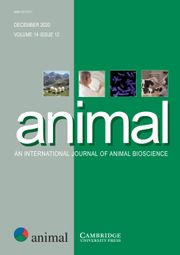Article contents
Carbohydrate-rich supplements can improve nitrogen use efficiency and mitigate nitrogenous gas emissions from the excreta of dairy cows grazing temperate grass
Published online by Cambridge University Press: 07 January 2020
Abstract
Temperate pasture species constitute a source of protein for dairy cattle. On the other hand, from an environmental perspective, their high N content can increase N excretion and nitrogenous gas emissions by livestock. This work explores the effect of energy supplementation on N use efficiency (NUE) and nitrogenous gas emissions from the excreta of dairy cows grazing a pasture of oat and ryegrass. The study was divided into two experiments: an evaluation of NUE in grazing dairy cows, and an evaluation of N-NH3 and N-N2O volatilizations from dairy cow excreta. In the first experiment, 12 lactating Holstein × Jersey F1 cows were allocated to a double 3 × 3 Latin square (three experimental periods of 17 days each) and subjected to three treatments: cows without supplementation (WS), cows supplemented at 4.2 kg DM of corn silage (CS) per day, and cows supplemented at 3.6 kg DM of ground corn (GC) per day. In the second experiment, samples of excreta were collected from the cows distributed among the treatments. Aliquots of dung and urine of each treatment plus one blank (control – no excreta) were allotted to a randomized block design to evaluate N-NH3 and N-N2O volatilization. Measurements were performed until day 25 for N-NH3 and until day 94 for N-N2O. Dietary N content in the supplemented cows was reduced by 20% (P < 0.001) compared with WS cows, regardless of the supplement. Corn silage cows had lower N intake (P < 0.001) than WS and GC cows (366 v. 426 g/day, respectively). Ground corn supplementation allowed cows to partition more N towards milk protein compared with the average milk protein of WS cows or those supplemented with corn silage (117 v. 108 g/day, respectively; P < 0.01). Thus, even though they were in different forms, both supplements were able to increase (P < 0.01) NUE from 27% in WS cows to 32% in supplemented cows. Supplementation was also effective in reducing N excretion (761 v. 694 g/kg of Nintake; P < 0.001), N-NH3 emission (478 v. 374 g/kg of Nmilk; P < 0.01) and N-N2O emission (11 v. 8 g/kg of Nmilk; P < 0.001). Corn silage and ground corn can be strategically used as feed supplements to improve NUE, and they have the potential to mitigate N-NH3 and N-N2O emissions from the excreta of dairy cows grazing high-protein pastures.
Information
- Type
- Research Article
- Information
- Copyright
- © The Animal Consortium 2020
References
- 8
- Cited by

